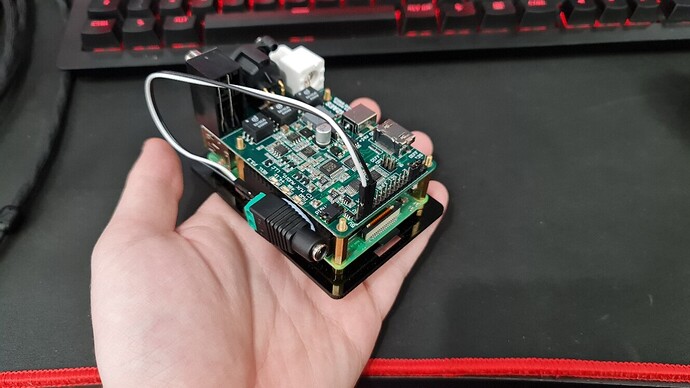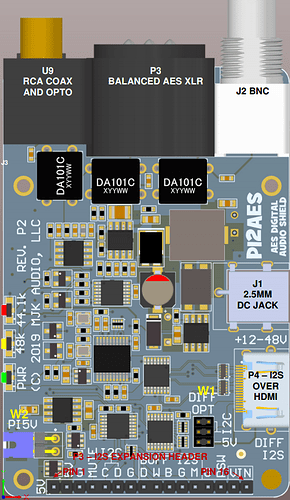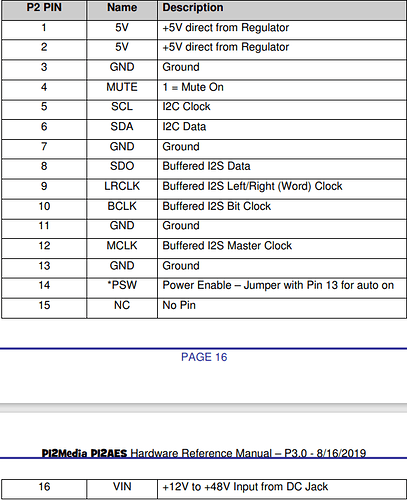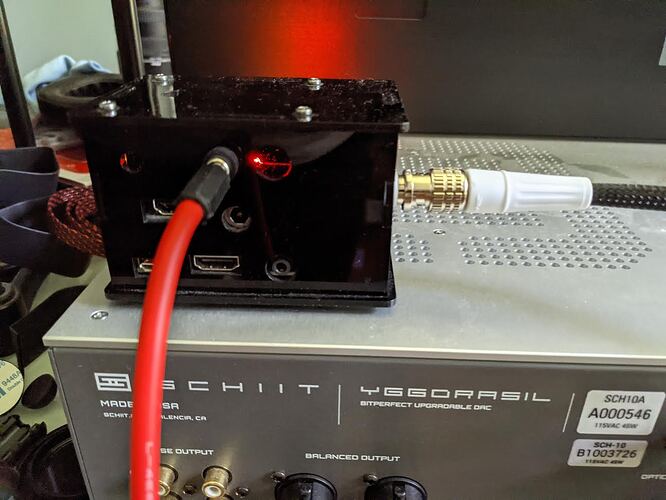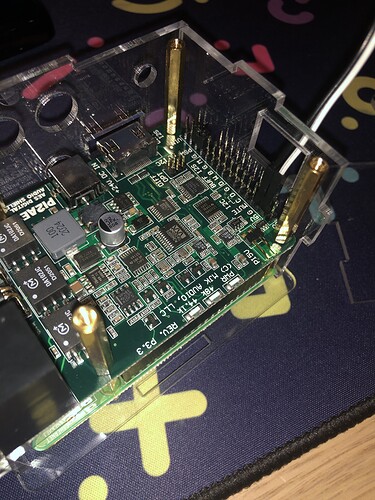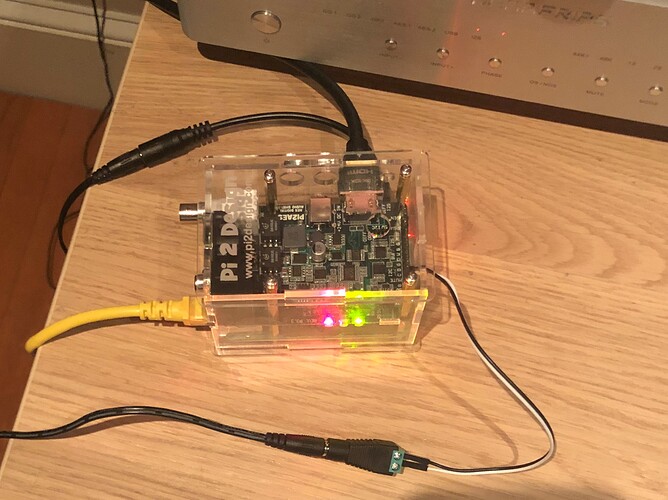I just bought the Singxer SU-6 DDC. I almost got the Pi2AES, but I don’t wanna deal with Raspberry Pi setup + wireless tech.
It’s actually pretty straight forward. This guide covers just about everything you’re going to need and I’ll help you with the rest.
I dove head first into the bridge idea and getting all music endpoints out of the PC. I picked up this SOtM but apparently I got lucky, the seller didn’t know it was a special edition, neither did I until I just caught the details on the label. Should have it tomorrow. I’m keeping the Pi2AES for my desktop and this for my 2 channel stereo.
That Singxer looks pretty sweet though!
It uses a super cap system to power the unit. Pretty good for the price. I picked it up on Amazon for $585.
Hi @M0N , sorry for digging out an old post but can I ask a couple of questions regarding this part of the chain (is it still called transport?) now that I have almost built the rest? I generally find your advice really helpful and thank you so much in advance.
Is Pi2AES a better option than, say, other Pi-based streamers such as the Allo Digi+ or DDC such as Singxer SU2/SU6? For one it’s probably cheaper (only with Meanwell PSU).
Regarding better power supply of Pi2AES, is it possible to, say, get an SBooster 24V or equivalent and split it into two, one for the Pi2AES and one for RNHP? (Trying to save a socket and a bit of the cost here)
Lastly, at the moment I am just using a MacBook (and I use some streaming services such as Qobuz but mostly ALAC files in iTunes ripped from CDs and I don’t have a strong need for hi-res tbh) with USB, will a solution like Pi2AES or a DDC make a noticeable sonic improvement?
Many thanks again!
Most of your questions will be answered here.
Most of the sonic benefits from the Pi2AES will come from it being a network bridge where you can get off of USB. A DDC on the other hand may be a better solution if your plan is to get music out of a PC via USB. BTW since you mention having the BF2. The Unisom USB is pretty good, but it’s still bettered by the BNC or AES output from the Pi2AES into my Yggdrasil.
Cheers, will read more into that.
Hi @GoldenOne,
I stumbled upon your review of Chord M Scaler vs HQPlayer recently, and I have been learning a lot from your other reviews on other DACs / audio equipment so far!
A few questions for you…
- Would you be sharing your steps in building the Pi2AES (hardware & software) some time soon?
- Regarding the RPi4, did you find USB 2.0 or 3.0 to be better (noise, jitter) when feeding a DAC? If the DAC matters, I’m interested in how it works with my Chord Mojo from Moode right now, as for future DACs I plan on exploring the I2S route.
Thanks!
Here you go:
thanks! i also noticed db_Cooper’s post right after replying so i’ll read up on that as well.
i’m most interested in how to get the custom 5V PSU support as that would make the iFi iPower X a great option to power the devices
Take a look at this picture, it’s pretty much all you have to do. I glued that adapter from the inside when I built mine so there are no external wires. It works very well and one LPS powers everything. The board is clearly labeled as well so it’s hard to screw things up.
Ugh I don’t remember the exact pins but there’s a pin jumper change you make on the Pi2AES board and it stops 5V going to Pi board. Then you can use the 5V power directly to Pi board. Do a search on SBAF and you should find the details.
thanks for the quick replies @db_Cooper and @A_Jedi !!
i’ll spend some time reading over those guides and start planning my build
This image shows it a little more clearly. There is a 5v pin and gnd pin which you can directly connect a 5v psu to in order to bypass the onboard switcher and power the pi2aes (and pi) with 5v direct. This allows you to use something like an ifi ipower or LPS.
In this image white is 5v and black is gnd
Easiest way is to get some male to female jumper leads and a DC barrel adapter. Plus PSU of your choice. This way there’s no soldering or ‘diy’ stuff needed. literally just plug it together and you’re good.
Kinda have to buy the bigger packs of both but they’re super cheap anyway. Will cost ~$15 for both
Once that’s done, decide if you’re going to power the pi separately or with your 5v PSU. If powering both, I’d strongly recommend getting one that is at least 2a. If you only have a 1a psu like the topping p50 then you probably want to power them separately.
If you’d like to power them separately, remove the jumper circled in this image.
If you’d like to power both from one PSU, leave it on.
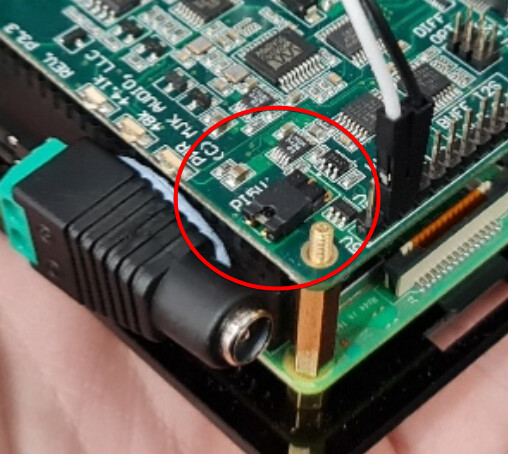
Lastly, for the OS I personally would recommend RopieeeXL ( RoPieee | XL ). Supports roon, DNLA/UPNP, spotify connect, airplay, HQPlayer and just about anything you could need.
In Ropiee (or your chosen OS), enable SSH, connect, and edit the config.txt ( sudo nano /boot/config.txt by default ) and add the following to the file:
arm_freq=900
arm_freq_max=900
arm_freq_min=150
gpu_freq=250
core_freq_min=250
sdram_freq_min=250
over_voltage=-3
over_voltage_min=-8
initial_turbo=30
temp_limit=60
This will underclock the pi and reduce power consumption, to ensure you don’t end up with any psu issues which I’ve found sometimes happens on some 2a/2.5a psus.
Thanks I will give this a try with my Allo Shanti. Shanti Dual Linear Ultra Low Noise PSU although I’ll need to order some wires first. I asked Michael Kelly about this and he said that this can bypass the esd and over voltage protection. Is that true or something you’ve had any issues with?
This is probably true yes so do this at your own risk. As long as you aren’t using a dodgy PSU then it’s fine. Wouldn’t recommend doing this with one of those aliexpress linear PSUs (and wouldn’t recommend using one of those in ANY situation, seriously PSUs are the one thing you do not want to screw about with or cheap out on). But if you have an allo, ifi ipower, sbooster or other proper reliable model then it’s fine
I wanted to clarify the pins to plug into and found these images in the pi2aes documentation.
As it shows in @GoldenOne picture, pins 2 and 3 are what is needed for connecting an external supply. The wires that I require to connect all of this arrive tomorrow so I’ll post some impressions of how it all sounds tomorrow hopefully
@GoldenOne thank you very much for the detailed response!!
one more question…
when using rpi 4 USB out to a dac, did you find the USB 2.0 or 3.0 ports to measure better in regards to jitter & noise on the dac’s analog out??
Hey @GoldenOne I pinged you the other day since I’m interested in your comentary of the SOtM. I picked one up and it turned out to be a special edition. Streamer/DDC Showdown: Pi2AES vs Sotm SMS200 Ultra Neo - #15 by db_Cooper
A lot of hardware (with one of the new ifi Power Elite) and it’s seem about the same, maybe I’d give it a slight edge compared to the Pi2AES with a 5v LPS. The SOtM has to feed USB out to my Lampi, where the Pi could use the BNC which is stated to be SE AES on the Pi2 so that helps keep it in the game.
All in $350 for the complete Pi setup to $1800 for the SOtM, so five times the cost and it more than holds its own.
Is the suggested underclock only to weed out iffy power supplies or does the reduced processing help to further reduce noise?
So if you take that 5v connector and glue it into the case from inside, you can keep everything nice and tidy so no external wiring.
I ssh’d to the rpi and edited the config file per the instructions then did the following. Plugged in the pi2aes to my shanti linear power supply from Allo. I connected the 3A output to the pi and the 1A output to the pi2aes as that was how I connected it up when I was using the digione board. Maybe I could just power both with the 3A connection, I’m not sure. Btw both of the power outputs are 5V. Nothing seems to have gone wrong but I haven’t listened yet as I’m waiting for my amp to warm up. Will update with some impressions later.
Chain is pi2aes (i2s) → Denafrips Pontus II → Flux FA-12 → LCD-4z and HD800S
